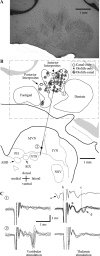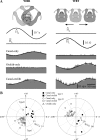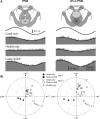Convergence of vestibular and neck proprioceptive sensory signals in the cerebellar interpositus
- PMID: 23325256
- PMCID: PMC3711745
- DOI: 10.1523/JNEUROSCI.3460-12.2013
Convergence of vestibular and neck proprioceptive sensory signals in the cerebellar interpositus
Abstract
The cerebellar interpositus nucleus (IN) contributes to controlling voluntary limb movements. We hypothesized that the vestibular signals within the IN might be transformed into coordinates describing the body's movement, appropriate for controlling limb movement. We tested this hypothesis by recording from IN neurons in alert squirrel monkeys during vestibular and proprioceptive stimulation produced during (1) yaw head-on-trunk rotation about the C1-C2 axis while in an orthograde posture and (2) lateral side-to-side flexion about the C6-T3 axis while in a pronograde posture. Neurons (44/67) were sensitive to vestibular stimulation (23/44 to rotation and translation, 14/44 to rotation only, 7/44 to translation only). Most neurons responded during contralateral movement. Neurons (29/44) had proprioceptive responses; the majority (21/29) were activated during neck rotation and lateral flexion. In all 29 neurons with convergent vestibular and neck proprioceptive input those inputs functionally canceled each other during all combined sensory stimulation, whether in the orthograde or pronograde posture. These results suggest that two distinct populations of IN neurons exist, each of which has vestibular sensitivity. One population carries vestibular signals that describe the head's movement in space as is traditional for vestibular signals without proprioceptive signals. A second population of neurons demonstrated precise matching of vestibular and proprioceptive signals, even for complicated stimuli, which activated the semicircular canals and otolith organs and involved both rotation and flexion in the spine. Such neurons code body (not head) motion in space, which may be the appropriate platform for controlling limb movements.
Figures







Similar articles
-
Neck proprioceptive inputs to primate vestibular nucleus neurons.Exp Brain Res. 2000 Dec;135(4):511-26. doi: 10.1007/s002210000542. Exp Brain Res. 2000. PMID: 11156315
-
Integration of vestibular and head movement signals in the vestibular nuclei during whole-body rotation.J Neurophysiol. 1999 Jul;82(1):436-49. doi: 10.1152/jn.1999.82.1.436. J Neurophysiol. 1999. PMID: 10400970
-
Multimodal integration in rostral fastigial nucleus provides an estimate of body movement.J Neurosci. 2009 Aug 26;29(34):10499-511. doi: 10.1523/JNEUROSCI.1937-09.2009. J Neurosci. 2009. PMID: 19710303 Free PMC article.
-
Gravity or translation: central processing of vestibular signals to detect motion or tilt.J Vestib Res. 2003;13(4-6):245-53. J Vestib Res. 2003. PMID: 15096668 Review.
-
Otolith and canal integration on single vestibular neurons in cats.Exp Brain Res. 2005 Jul;164(3):271-85. doi: 10.1007/s00221-005-2341-7. Epub 2005 Jul 1. Exp Brain Res. 2005. PMID: 15991028 Review.
Cited by
-
Relationships between cervical sagittal posture, muscle endurance, joint position sense, range of motion and level of smartphone addiction.BMC Musculoskelet Disord. 2023 Jan 23;24(1):61. doi: 10.1186/s12891-023-06168-5. BMC Musculoskelet Disord. 2023. PMID: 36690958 Free PMC article.
-
Neck proprioception shapes body orientation and perception of motion.Front Hum Neurosci. 2014 Nov 4;8:895. doi: 10.3389/fnhum.2014.00895. eCollection 2014. Front Hum Neurosci. 2014. PMID: 25414660 Free PMC article. Review.
-
Supervised-not voluntary-upper limb exercise enhances vestibular function in Parkinson's disease.Front Neurol. 2025 Jul 8;16:1618719. doi: 10.3389/fneur.2025.1618719. eCollection 2025. Front Neurol. 2025. PMID: 40697580 Free PMC article.
-
Vestibular nucleus neurons respond to hindlimb movement in the decerebrate cat.J Neurophysiol. 2014 Jun 15;111(12):2423-32. doi: 10.1152/jn.00855.2013. Epub 2014 Mar 26. J Neurophysiol. 2014. PMID: 24671527 Free PMC article.
-
The brain-body disconnect: A somatic sensory basis for trauma-related disorders.Front Neurosci. 2022 Nov 21;16:1015749. doi: 10.3389/fnins.2022.1015749. eCollection 2022. Front Neurosci. 2022. PMID: 36478879 Free PMC article. Review.
References
-
- Anastasopoulos D, Mergner T, Becker W, Deecke L. Sensitivity of external cuneate neurons to neck rotation in three-dimensional space. Exp Brain Res. 1991;85:565–576. - PubMed
-
- Angelaki DE, Dickman JD. Spatiotemporal processing of linear acceleration: primary afferent and central vestibular neuron responses. J Neurophysiol. 2000;84:2113–2132. - PubMed
-
- Arshavskiı̆ Iu I, Orlovskiı̆ GN, Pavlova GA. [Vestibular reactions of neurons of the cerebellar nucleus dentatus and nucleus interpositus in cats] Neirofiziologiia. 1980;12:93–96. - PubMed
-
- Bakker DA, Richmond FJ, Abrahams VC, Courville J. Patterns of primary afferent termination in the external cuneate nucleus from cervical axial muscles in the cat. J Comp Neurol. 1985;241:467–479. - PubMed
Publication types
MeSH terms
Grants and funding
LinkOut - more resources
Full Text Sources
Other Literature Sources
Medical
Miscellaneous
